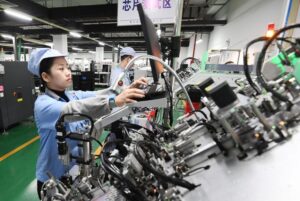Ripple Effects of the EU-China Tariff Dispute: Challenges and Opportunities for Small Players in the Global Supply Chain
“If the flame fell on the cedars, what will the moss on the wall do?” This powerful proverb encapsulates the precarious position of smaller players in the global supply chain as the EU-China tariff dispute intensifies. Germany’s automotive industry, renowned for its high standards in engineering and manufacturing, is heavily dependent on China for sourcing essential components like EV batteries and electronic modules. With new tariffs between 7.8% and 35.3% on Chinese electric vehicles and parts, even Germany’s auto giants are struggling to maintain their competitive edge. As these large corporations—symbolic “cedars”—grapple with the fallout, the smaller businesses that supply or support them—the “moss on the wall”—face a daunting set of challenges.
The Pressure on Global Giants: A Shifting Sourcing and Supply Chain Landscape
Germany’s automotive industry stands as a global manufacturing leader but is deeply intertwined with China’s supply chain. The recent tariffs, aimed at countering “unfair” Chinese subsidies, are disrupting this well-established sourcing relationship. This comes at a time when carmakers are already dealing with high production costs, supply chain shortages, and a pivot toward sustainable transportation.
These tariffs put intense pressure on German carmakers to find alternative sourcing for critical parts, adding significant costs to manufacturing and logistics. For major players, this may be a difficult but achievable task. However, for SMEs that depend on these manufacturers for orders, the impact is even more profound.
What the Tariffs Mean for SMEs in Manufacturing and Supply Chain Networks
For small and medium-sized enterprises (SMEs) supplying parts or services to Germany’s auto giants, the tariff dispute poses an existential threat. These smaller suppliers are typically less diversified in their sourcing and rely on stable demand from large manufacturers. Without the capital reserves, flexibility, or global reach of larger firms, SMEs are finding it challenging to adapt.
The risk heightens further if China retaliates by imposing tariffs or restricting exports of essential components, which would disrupt the supply chain for these smaller players. Lacking the same bargaining power and logistical networks as larger companies, SMEs could face production slowdowns, increased costs, and even insolvency if they are unable to source from alternative suppliers.
The Broader Impact of a Trade Standoff: Consequences Across the Supply Chain
If the EU-China dispute escalates into a full-blown trade war, the effects would be far-reaching, with smaller businesses caught in the crossfire. Supply chains across multiple sectors—not only automotive—could experience cascading disruptions, with halted production lines, surging prices, and widespread job losses.
SMEs integrated deeply within these supply chains may find it difficult, if not impossible, to shift their sourcing and manufacturing operations to alternative markets in the short term. Potential retaliatory actions from China, such as targeting European goods or imposing stringent regulations on foreign businesses, would further complicate an already challenging environment for SMEs.
Survival Strategies for SMEs: Building Resilience in Sourcing and Manufacturing
While the challenges are significant, SMEs can adopt proactive strategies to adapt to the evolving trade landscape. Key survival tactics include:
Diversification of Sourcing and Manufacturing Locations
SMEs should explore sourcing options outside China, looking to emerging markets like Vietnam, India, or Indonesia. These regions offer competitive production costs and may mitigate risks tied to the EU-China trade dispute. Additionally, forming partnerships in these alternative markets can enhance sourcing options and manufacturing capacity, creating greater resilience.Flexible and Agile Supply Chains
To manage the volatility of tariffs and trade restrictions, SMEs need to invest in more adaptable supply chains. Strategies such as dual-sourcing, building inventory buffers, and implementing responsive logistics can help mitigate sudden disruptions. This flexibility in sourcing and supply chain management can enhance an SME’s ability to continue meeting customer demand despite external challenges.Strengthening Financial Resilience
Given the unpredictability in sourcing and supply chain costs, maintaining strong financial health is crucial. SMEs can explore financial support options like government grants, low-interest loans, or private equity to fortify their balance sheets and improve cash flow. By building a financial buffer, SMEs can better navigate the pressures of increased production and sourcing costs.Staying Informed on Regulatory and Trade Developments
Regularly monitoring changes in tariffs, trade negotiations, and supply chain regulations is essential for anticipating shifts and preparing timely responses. SMEs that stay informed and engaged with trade developments will be better positioned to adapt sourcing, manufacturing, and logistics strategies as conditions change.
Conclusion: Adapting to a New Reality in Sourcing, Manufacturing, and Supply Chains
The EU-China tariff dispute serves as a wake-up call for businesses large and small, with lasting implications for global sourcing, manufacturing, and supply chain management. For SMEs, the key to navigating this turbulent landscape lies in adaptability, diversification, and financial resilience. The proverb “If the flame fell on the cedars, what will the moss on the wall do?” reminds us that no business is immune to global trade conflicts. By taking proactive steps to strengthen their sourcing and supply chains, SMEs can position themselves not only to survive but to thrive in the face of ongoing trade shifts.

